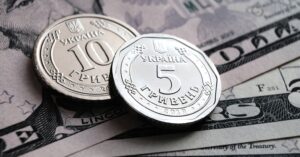
Ukraine’s real gross domestic product (GDP) grew by 5.3% in 2023 compared to the previous year, when it fell by 28.8%, according to preliminary data released by the State Statistics Service on Thursday.
According to the data, nominal GDP last year amounted to UAH 6 trillion 537.8 billion, with a change in the deflator of 18.5%.
The State Statistics Service clarified that in the first quarter of 2023, the decline in real GDP compared to the same period last year amounted to 10.3% of GDP, after which it grew by 19.2% in the second quarter, 9.6% in the third and 4.7% in the fourth.
Earlier, in December last year, the statistical agency estimated a 10.5% decline in the first quarter, followed by a 19.5% increase in the second and a 9.3% increase in the third.
Nominal GDP in the fourth quarter amounted to UAH 1 trillion 933.0 billion, compared to UAH 1 trillion 778.4 billion in the third quarter, UAH 1 trillion 463.9 billion in the second quarter and UAH 1 trillion 362.5 billion in the first quarter, according to the State Statistics Service.
As reported, in January, the National Bank of Ukraine estimated the country’s GDP growth in 2023 at 5.7%, and its nominal value at UAH 6.51 trillion. The NBU maintained its GDP growth forecast for 2024 at 3.6% (nominal UAH 7.58 trillion), slightly downgrading it for 2025 from 6.0% to 5.8%. At the same time, for the first quarter of this year, the NBU improved its GDP growth forecast to 7.1% from 5.4%, expecting it to slow to 4.8% in the second quarter.
When approving the draft state budget for the second reading in early November 2023, the government improved its estimate of GDP growth last year from 2.8% to 5%, but downgraded it for 2024 from 5% to 4.6%. According to the Ministry of Economy, GDP growth in January-February this year was 3.6%.
In its updated EFF program with Ukraine, the IMF estimated real GDP growth in 2023 at 5% and nominal GDP at UAH 6.5 trillion. It forecasts a slowdown to 3-4% this year, and an increase in nominal GDP to UAH 7.75 trillion.
For more details on macroeconomic indicators of Ukraine and the world, please see one of the video analyzes of the Experts club think tank – https://youtu.be/w5fF_GYyrIc?si=Ymo-FlMFNGfLLdK-
You can subscribe to the channel here: https://www.youtube.com/@ExpertsClub

The ruling party of South Korean President Yun Seok-yol “People’s Power” is leading in popularity according to the results of a public poll ahead of the parliamentary elections scheduled for April, Western media reported citing data from a survey by the Gallup Korea organization.
Thus, according to the survey, about 37% of voters are ready to support the “People’s Power”, while 29% intend to vote for the main opposition Democratic Party. The third most popular among South Koreans is the Korea Innovation Party – it has 12%. This is a new party, it was created by politician Cho Guk, who served as Minister of Justice under President Moon Jae-in.
The poll was conducted by Gallup Korea organization among more than 1 thousand people.
Parliamentary elections in the country are scheduled for April 10.
Earlier, the Experts Club analytical center and Maxim Urakin presented an analytical material on the most important elections in the countries of the world in 2024, more detailed video analysis is available here – https://youtu.be/73DB0GbJy4M
Subscribe to the channel here: https://www.youtube.com/@ExpertsClub

The article collects and analyzes the main macroeconomic indicators of Ukraine. In connection with the entry into force of the Law of Ukraine “On Protection of the Interests of Economic Entities during Martial Law or State of War” the State Statistics Service of Ukraine suspends the publication of statistical information for the period of martial law, as well as for three months from the date of its completion. The exception is the publication of information about the consumer price index, separate information on statistical indicators of 2021 and for the period January-February 2022. The article analyzes open data from the State Statistics Committee, the National Bank and analytical centers.
Maxim Urakin, PhD in Economics, presented an analysis of macroeconomic trends in Ukraine and the world based on official data from the State Statistics Committee of Ukraine, the NBU, the UN, the IMF and the World Bank.
Macroeconomic indicators of Ukraine
Maxim Urakin cited data from the National Bank of Ukraine on the improvement of the financial situation in 2023 compared to 2022.
“Last year was marked by a more favorable macroeconomic environment for the financial industry. GDP growth generally exceeded forecasts and inflation rates declined. Even after the downgrade, the discount rate remains high enough to make hryvnia investments attractive. Thanks to the efforts of the National Bank and market readiness, the transition to a policy of managed flexibility of the hryvnia exchange rate was successful. At the same time, this success was ensured primarily by stable receipts from partners within the framework of macrofinancial assistance and an increase in the share of exports of agricultural products,” Urakin emphasized.
The expert noted that the main risks for the economy remain the duration of the war and instability of international aid.
“In the third quarter of 2023, Ukraine’s GDP growth slowed to 8.2%. The negative balance of foreign trade increased by 3.2 times, which is a worrying signal. Public debt has slightly decreased compared to August figures, but in 2024 it may exceed the country’s GDP for the first time, which poses significant risks to economic stability,” the economist said.
The pace of international aid to Ukraine, in turn, has significantly decreased in the IV quarter of 2023 – I quarter of 2024, which could create significant risks to the country’s economic stability,” the economist said.
I quarter of 2024, which may negatively affect the recovery of the economy in the current year under the conditions of war.
Global Economic Outlook
Maxim Urakin also analyzed the global economy, noting a slowdown in growth to 2.2% in 2024.
“Analyzing the dynamics of global GDP shows that the global economy continues to recover from the pandemic, but geopolitical instability has a restraining effect on this growth. According to Maxim Urakin, it is important to monitor developments and adapt to changing conditions to ensure sustainable economic growth in the future. Ukraine, in this context, needs to focus on strengthening domestic political stability, restoring its economic potential and continuing reforms to improve its post-war prospects and strengthen its position on the global stage,” the expert explained.
According to the expert, the current macroeconomic situation in Ukraine and the world requires further analysis. For Ukraine, the main challenges in the coming years will be the need to rebuild Ukraine after the war and public debt management.
Earlier, the Experts Club analytical center released a video on how the GDP of countries has been changing in recent years, more video analysis is available here.

Germany’s economy will avoid recession in 2024, but will grow by only 0.1% due to declining exports and weak domestic demand, according to leading German research institutes.
The previous forecast, prepared by the Munich-based Institute for Economic Research (IFO), the Kiel-based Institute for World Economics (IfW), the Rhineland-Westphalian Institute for Economic Research in Essen (RWI) and the Institute for Economic Research in Halle (IWH), predicted German GDP growth of 1.3%.
In 2023, the German economy shrank by 0.3%.
The economists warned that domestic demand is growing more slowly than expected, and exports are suffering due to high electricity prices, which reduce the competitiveness of German energy-intensive goods.
“Cyclical and structural factors are leading to a weakening of economic growth,” said Stefan Koots, head of economic research at the IfW. – “A recovery may begin in the spring, but overall, the growth momentum will not be very strong.
In 2025, according to experts, Germany’s GDP growth will accelerate to 1.4%.
The forecast for inflation for 2024 is 2.3%, for 2025 – 1.8%.
Earlier, Experts Club analytical center released a video analysis of GDP changes in major countries, the video is available at https://youtu.be/w5fF_GYyrIc?si=EpL-_EmhIGfMURGl

The article collects and analyzes the main macroeconomic indicators of Ukraine. In connection with the entry into force of the Law of Ukraine “On Protection of the Interests of Economic Entities during Martial Law or State of War” the State Statistics Service of Ukraine suspends the publication of statistical information for the period of martial law, as well as for three months from the date of its completion.
The exception is the publication of information about the consumer price index, separate information on statistical indicators of 2021 and for the period January-February 2022. The article analyzes open data from the State Statistics Committee, the National Bank and analytical centers.
Maxim Urakin, PhD in Economics, presented an analysis of macroeconomic trends in Ukraine and the world based on official data from the State Statistics Committee of Ukraine, the NBU, the UN, the IMF and the World Bank.
Macroeconomic indicators of Ukraine
Maxim Urakin cited data from the National Bank of Ukraine on the improvement of the financial situation in 2023 compared to 2022.
“Last year was marked by more favorable macroeconomic conditions for the financial industry. GDP growth generally exceeded forecasts, and inflation rates declined. Even after the downgrade, the discount rate remains high enough to make hryvnia investments attractive. Thanks to the efforts of the National Bank and market readiness, the transition to a policy of managed flexibility of the hryvnia exchange rate was successful. At the same time, this success was ensured primarily by stable receipts from partners within the framework of macrofinancial assistance and an increase in the share of exports of agricultural products,” Urakin emphasized.
The expert noted that the main risks for the economy remain the duration of the war and instability of international aid.
“In the third quarter of 2023, Ukraine’s GDP growth slowed to 8.2%. The negative balance of foreign trade increased by 3.2 times, which is a worrying signal. Public debt has slightly decreased compared to August figures, but already in 2024 it may exceed the country’s GDP for the first time, which poses significant risks to economic stability,” the economist said.
The pace of international aid to Ukraine, in turn, has fallen significantly in Q4 2023 – Q1 2024, which could negatively affect the economic recovery this year amid the war.
Global Economic Outlook
Maxim Urakin also analyzed the global economy, noting a slowdown in growth in 2024 to 2.2%.
“The analysis of global GDP dynamics shows that the global economy continues to recover from the pandemic, but geopolitical instability has a restraining effect on this growth. According to Maxim Urakin, it is important to monitor developments and adapt to changing conditions to ensure sustainable economic growth in the future. Ukraine, in this context, needs to focus on strengthening domestic political stability, restoring its economic potential and continuing reforms to improve its post-war prospects and strengthen its position on the global stage,” the expert explained.
According to the expert, the current macroeconomic situation in Ukraine and the world requires further analysis. For Ukraine, the main challenges in the coming years will be the need to rebuild Ukraine after the war and public debt management.
Earlier, the Experts Club analytical center released a video on how the GDP of countries has been changing in recent years, more detailed video analysis is available here.

In his analytical video published on the Experts Club YouTube channel, Maxim Urakin, founder of the project and PhD in Economics, focuses on the key indicator of global macroeconomics – gross domestic product (GDP), which plays a central role in analyzing the economic well-being of countries. GDP is the total value of all goods and services produced in a country over a certain period of time. This indicator helps to assess how productive a country’s economy is and is an important indicator of its overall economic well-being.
Analyzing GDP dynamics on a global scale
According to Urakin, analyzing the last decades shows significant changes in the global economy.
“In the 1990s to 2000s, first of all, there was significant economic growth in countries such as the US and China, as well as in developing countries such as India. It was a time of economic prosperity for developed countries and a period of rapid growth for some emerging markets,” explained the founder of Experts Club.
But then the world economy was rocked by crises, including the global financial crisis of 2008 and the subsequent European debt crisis. These events, according to Expert Club, slowed global GDP growth and exposed the vulnerability of many economies previously considered promising.
“In recent years, we have faced new challenges, such as the COVID-19 pandemic, which led to a significant downturn in the global economy, and geopolitical tensions, including the war in Ukraine. These events have re-emphasized the interconnectedness and interdependence in the global economy,” said Urakin.
GDP and geopolitical changes
Urakin notes that in the context of geopolitics, GDP serves not only as a measure of economic development but also as an indicator of international influence.
“India, surpassing the UK, has become the fifth largest economy in the world, which emphasizes the shift of global economic forces to the Asian region. This is also confirmed by the fact that China, having overtaken the US in terms of purchasing power, has confirmed its status as a global economic power,” the economist emphasized.
Future trends
Analysis of global GDP dynamics shows that the global economy continues to recover from the pandemic, but geopolitical instability has a restraining effect on this growth. According to Maxim Urakin, it is important to monitor developments and adapt to changing conditions to ensure sustainable economic growth in the future. Ukraine, in this context, needs to focus on strengthening domestic political stability, restoring economic potential and continuing reforms to improve its post-war prospects and strengthen its position on the global stage.
To learn more about global GDP, check out the video on the Experts Club channel at the link:
You can subscribe to the channel here:
https://www.youtube.com/@ExpertsClub
GDP (Gross Domestic Product) is the total market value of all final goods and services produced in a country over a given period of time (usually a year). It measures a country’s total output and economic activity, being one of the key indicators of its economic health.
Nominal GDP is an estimate of gross domestic product expressed in current market prices, not adjusted for inflation or deflation. This means that when measuring nominal GDP, current prices of goods and services are taken into account, which can lead to higher GDP when prices rise (inflation), even if actual output has not increased.
PPP (Purchasing Power Parity) GDP is a method of estimating GDP that takes into account differences in the cost of living and price level between countries. The PPP GDP calculation uses prices adjusted to reflect real purchasing power in different countries. This allows for a more accurate comparison of living standards and economic activity between countries because it takes into account differences in the cost of goods and services in different places.